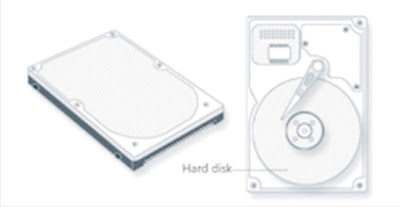Parts of a Computer
If you use a desktop computer, you might already know
that there isn't any single part called the "computer." A computer is
really a system of many parts working together. The physical parts, which you
can see and touch, are collectively called hardware.
(Software, on the other hand, refers to the
instructions, or programs, that tell the hardware what to do.)
The following illustration shows the most common hardware
in a desktop computer system. Your system might look a little different, but it
probably has most of these parts. A laptop computer has similar parts but
combines them into a single, notebook-sized package.
System
unit
The system unit is the core of
a computer system. Usually it's a rectangular box placed on or underneath your
desk. Inside this box are many electronic components that process information.
The most important of these components is the central
processing unit (CPU), or microprocessor,
which acts as the "brain" of your computer. Another component is random access memory (RAM), which temporarily stores
information that the CPU uses while the computer is on. The information stored
in RAM is erased when the computer is turned off.
Almost every other part of your computer connects to the
system unit using cables. The cables plug into specific ports
(openings), typically on the back of the system unit. Hardware that is not part
of the system unit is sometimes called a peripheral device
or device.
Storage
Your computer has one or more disk
drives—devices that store information on a metal or plastic disk. The
disk preserves the information even when your computer is turned off.
Your computer's hard disk drive
stores information on a hard disk—a rigid platter or
stack of platters with a magnetic surface. Because hard disks can hold massive
amounts of information, they usually serve as your computer's primary means of
storage, holding almost all of your programs and files. The hard disk drive is
normally located inside the system unit...
CD and DVD drives
Nearly all computers today come equipped with a CD or DVD
drive, usually located on the front of the system unit. CD drives use lasers to
read (retrieve) data from a CD; many CD drives can also write (record) data
onto CDs. If you have a recordable disk drive, you can store copies of your
files on blank CDs. You can also use a CD drive to play music CDs on your
computer.
CD
DVD drives can do everything that CD drives can, plus
read DVDs. If you have a DVD drive, you can watch movies on your computer. Many
DVD drives can record data onto blank DVDs.
Tip
If
you have a recordable CD or DVD drive, periodically back up (copy) your
important files to CDs or DVDs. That way, if your hard disk ever fails, you
won't lose your data.
Floppy disk drive
Floppy disk drives store information on floppy disks, also called floppies
or diskettes. Compared to CDs and DVDs, floppy disks
can store only a small amount of data. They also retrieve information more
slowly and are more prone to damage. For these reasons, floppy disk drives are
less popular than they used to be, although some computers still include them.
Why are these disks called "floppy" disks? The
outside is made of hard plastic, but that's just the sleeve. The disk inside is
made of a thin, flexible vinyl material.
Mouse
A mouse typically has two buttons a primary button (usually the left button) and a secondary button (usually the right button). You will use the primary button most often. Most mice also include a scroll wheel between the buttons to help you scroll through documents and WebPages more easily. On some mice, the scroll wheel can be pressed to act as a third button. Advanced mice might have additional buttons that can perform other functions.
A mouse is a small device used to point to and select
items on your computer screen. Although mice come in many shapes, the typical
mouse does look a bit like an actual mouse. It's small, oblong, and connected
to the system unit by a long wire that resembles a tail. Some newer mice are
wireless.
A mouse usually has two buttons: A primary button
(usually the left button) and a secondary button. Many mice also have a wheel
between the two buttons, which allows you to scroll smoothly through screens of
information.
Mouse pointers
When you move the mouse with your hand, a pointer on your
screen moves in the same direction. (The pointer's appearance might change
depending on where it's positioned on your screen.) When you want to select an
item, you point to the item and then click (press
and release) the primary button. Pointing and clicking with your mouse is the
main way to interact with your computer.







No comments:
Post a Comment